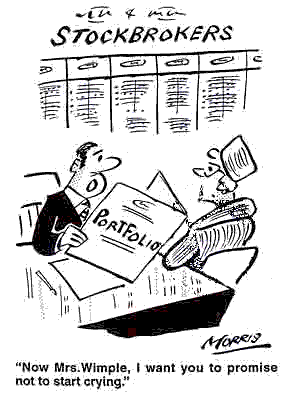An investor can chose to protect their bet against extreme adverse movements by setting pre-determined stop loss levels. If the instrument falls below/rises above these levels the bet is automatically closed at the level of the stop loss. Spread betting companies charge for this security in the form of wider spreads.
This works in much the same way a limited risk bet, except the closing trade is not guaranteed to be executed at the stop loss level.
The opposite of a stop loss. This is a pre-determined level at which a profit is taken.
 |
Here is a description of the kind of orders you can place (this information applies primarily to stock trading) and how they affect an execution.
A market order will typically assure you an execution, but not a specific price. When you send a market order, you ask it to be filled at whatever price is available when your order reaches its destination. In a volatile market, the fill price can be substantially different from the price that was quoted.
A limit order is an order to buy or sell a stock with a price restriction. A buy limit sets the maximum price you are willing to pay, and a sell limit sets the minimum price at which you are willing to sell. It guarantees you a specific price, but it does not guarantee you an execution.
For example, you may wish to purchase a stock that is currently quoted at 15 bid, 15 ¼ ask, but you do not want to pay more than $14. If you place a limit order at $14, it will be filled only if the price drops to $14 or lower and there are no orders ahead of yours. If the stock continues to trade at its current quote, you will not receive an execution.
A stop order is an order designed to protect a profit or guard against a loss. Although it does not work very well in all conditions, it can be an effective strategy in different situations. When placing a stop order, you specify a stock price that, when reached, converts your order to a market order.
For example, you may have purchased XZY stock at £40 and it is now trading at £60. If XZY drops to £50, you want to sell the stock. You can place a sell stop order at £50, and if the stock trades there, your order becomes a market order to sell. The risk with this type of order is that once triggered, your order can be filled at any price because it is a market order.
A stop limit order is a variation on the stop order. It works in a similar fashion in that it is triggered once the stock hits the stop price, but instead of becoming a market order, it becomes a limit order at the price that you select. Limit orders in a fast market will reduce your risk of receiving an unexpected execution price. What's more, a limit order allows you to place an order at the price level you're almost comfortable with when buying or selling a security. Although a limit order does not guarantee that your order will be executed, it does guarantee that you will not pay a higher price than you expected.
For example you want to limit losses on a stock that you purchased at $50. You enter a stop limit order at "$40 Stop $39 Limit". Once the stock trades at $40 or below, your order becomes a limit order to sell at £39. This will ensure that you will not sell at an extremely low price if a stock price opens drastically lower. However, you will still own the stock, since the order was not executed.
Each of the above orders has its pros and cons. You should pick the order that is best for your situation and considers current market conditions.
No part of this website (Financial-Spread-Betting.com) may be copied or imitated in whole or in part. No logo, graphic, sound or image from this website may be copied or re-transmitted unless expressly permitted in writing by the webmaster. Please report abuse to ![]() traderATfinancial-spread-betting.com (remove the AT and substitute by @).
traderATfinancial-spread-betting.com (remove the AT and substitute by @).